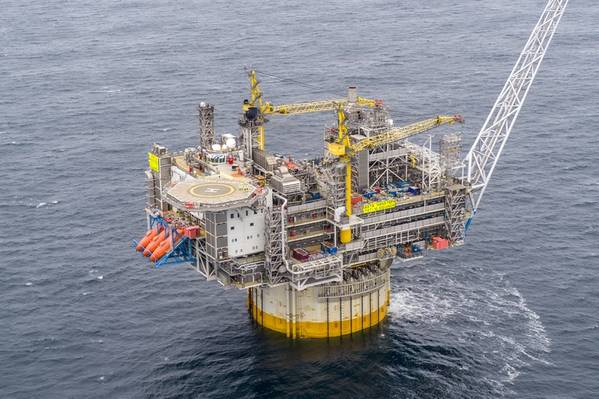
Production from the Aasta Hansteen gas field in the Norwegian Sea began Sunday, opening a new region for gas export to Europe, Norway's Equinor announced Monday.
The Aasta Hansteen field, named after the Norwegian feminist, social commentator, painter and author, is located 300 kilometers west of Sandnessjøen, far from other fields and in an area with harsh weather conditions.
“Located in 1,300 meters of water, this is the deepest field development on the Norwegian continental shelf (NCS), the largest spar platform in the world, and a first on the NCS. The field now coming on stream is unique,” said Anders Opedal, Equinor’s executive vice president for Technology, Projects and Drilling.
The field development concept consists of a 339-meter-tall, 70,000-metric-ton floating platform with a vertical cylindrical substructure moored to the seabed (spar platform). Gas is produced from seven wells in three subsea templates, the deepest ever installed on the NCS.
“Aasta Hansteen has been a complex and challenging development project, requiring us to take new technological steps together with our partners Wintershall, OMV and ConocoPhillips as well as the suppliers,” Opedal said.
Equinor is the operator of the field with an ownership interest of 51 percent. The other licensees are Wintershall Norge AS (24 percent), OMV (Norge) AS (15 percent) and ConocoPhillips Skandinavia AS (10 percent).
Gas from Aasta Hansteen will be transported in the 482-kilometer Polarled pipeline to the Nyhamna terminal (both operated by Gassco) for further export to the U.K. Produced condensate will be loaded into tankers and transported to the market.
Both Aasta Hansteen and the pipeline to Nyhamna has the capacity to accommodate new discoveries. The first one, Snefrid North, is already under development, and will come on stream towards the end of 2019.
The recoverable resources at Aasta Hansteen, including Snefrid North, are estimated at 55.6 billion standard cubic-meters (Sm3) of gas and 0.6 million Sm3 of condensate (353 million barrels of oil equivalent). Aasta Hansteen and Snefrid Nord is expected to produce some 23 million Sm3 of gas per (144,000 BOE) per day at plateau.
“The production from the Aasta Hansteen field will help secure long-term Norwegian gas export. With the infrastructure installed it will also be more attractive to explore around the platform and along the pipeline. This enables us to secure activity for many decades, in line with our ambitions for the NCS,” said Arne Sigve Nylund, Equinor’s executive vice president for Development and Production Norway. The exploration activity in the area around the field has already increased, and several discoveries have been made.
Although the substructure and topside structure were built in South Korea Aasta Hansteen has generated big spin-offs for Norwegian supply industry. More than half of the topside equipment packages were produced in Norway, and the subsea equipment is also Norwegian. The subsea templates were built in Sandnessjøen and the suction anchors keeping the gigantic platform in place are produced in Mo i Rana. The platform was hooked up at Stord south of Bergen, which is also where much of the hook up and commissioning work was performed.
“In the operations phase the field will be operated from Harstad, base services will be delivered from Sandnessjøen and the helicopter traffic will go from Brønnøysund.
“In the project phase Aasta Hansteen and Polarled have generated spin-offs for slightly more than NOK 16 billion in Norway, NOK 1.3 billion of which has benefitted companies in Nordland and southern Troms, and there will be more in the years to come operating the field,” Nylund said.
Some 32 million man-hours have been put into the Aasta Hansteen project, which has cost about NOK 37.5 billion (2018 value). The NOK 2.9 billion increase since the submission of the plan for development and production (PDO) is due to the currency effect due to the weak NOK. This is within the uncertainty range assumed in the cost estimate for the PDO.



